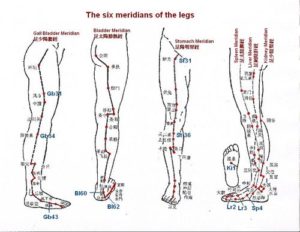The most common causes of ankle pain are bone fractures and strains and sprains of the soft tissues of the ankle.

Fractures
Fractures can occur on any of the 3 bones of the ankle: the tibial bone associated with Foot Jue Yin (LV) and Foot Yang Ming (ST); the fibula associated with Foot Shao Yang (GB); and the foot bone that sits above the heel bone called the talus which is associated with Foot Shao Yang (GB). The distal extremity of the fibula is called the lateral malleolus, and the distal end of the tibia is called the medial malleolus. All of these bones are susceptible to fracture which causes a lot of pain and swelling. Fracturing a bone in the ankle can also cause damage to the surrounding ligaments and tendons. From acupuncture point of view we want to target not just the fractured bone but all the inflamed tissue around the fracture. Needles have to touch the bone, tendons, ligaments and retinaculum depending which tissue has been harmed at the injury site.
Sprains & Strains
Ankle sprain is the over stretching or tearing of the ligaments of the ankle. Ligaments are the bands of tissue that connect two bones together in the ankle joint. Oddly enough the most common location for a sprain in the body is in fact the ankle joint. The injury is usually heard as a popping sound. The most common sprain is to the lateral ligaments on the outside of the ankle (GB and UB meridian). There can also be damage to the medial ligament which attaches the tibia to the medial side of the talus which then becomes a Foot Yang Ming issue (ST). Acupuncture points will target all tissue in the entire area of the injury that could be involved.
Ankle strain is the over stretching or tearing of muscles or tendons. Tendons are the dense fibrous cords of tissue that connect bones to muscles. Strains and sprains are confusing because the symptoms are almost the same. The main difference is that with a sprain you may see bruising around the affected joint, whereas with a strain you may have spasms in the affected muscle. In the ankle there are 2 tendons that are most often strained. These are the peroneal tendons that stabilize and protect the ankle. They are associated with both Foot Tai Yang (UB) and Foot Shao Yang (GB). The other tendon of the ankle which can become acutely torn is the achilles tendon associated with Foot Tai Yang (UB).
Tears to the tendon are called tendonitis and they feel warm to the touch. It is important to note that tendonitis could take years to develop.
Arthritis
Osteoarthritis or stiff ankle are arthritic lesions within the ankle causing pain and stiffness of the ankle joint. Rheumatoid arthritis or inflammatory arthritis causes swelling and inflammation to soft tissue of the ankle joint. This type of arthritis will always feel very warm to the touch. Acupuncture alone works for any kind of arthritic pain but for inflammatory arthritis it is best to add herbs to round out the treatment and ensure success.
Bursitis
Some common conditions of the bursa include achilles bursitis, retrocalcaneal bursitis, and bursitis of the medial malleolus. The achilles area is treated by targeting the Foot Tai Yang (UB) and the medial malleolus area of the ankle is associated with Foot Jue Yin (LV) and Foot Tai Yin (SP).
General principals:
Distal Needling Acupuncture for ankle pain is quite easy. The ankle is easily divided into the 6 Chinese Anatomical regions. Problems on the lateral side of the ankle, lower leg and foot are targeted as Foot Tai Yang and Foot Shao Yang problems. Pain and swelling of the anterior portion of the ankle is targeted as Foot Yang Ming. Medial pains and discomfort of the ankle are usually both Foot Jue Yin and Foot Tai Yin issues. Foot Shao Yin is more associated with a calcaneus problem and pain radiating into the bottom of the foot.
Needle should touch the same tissue that is damaged in the ankle. Tendons treat tendons, fascia treats fascia, muscles treat muscles, ligaments treat ligaments, bones treat bones. Use more than one needle at each needling site into the same spot for more stimulation if needed.
Since no needle in the ankle, right after needle insertion, patient will be instructed to move the ankle. Majority patients will instantly get 80% better when they move their painful ankle. We recommend patients to have acupuncture 3 times a week until the pain is half gone then 2 times a week until it is gone.